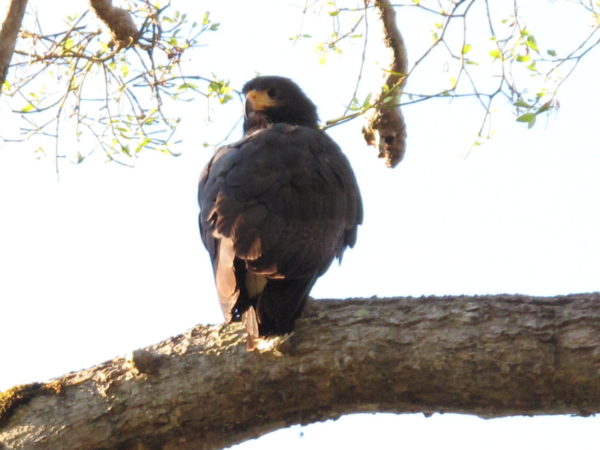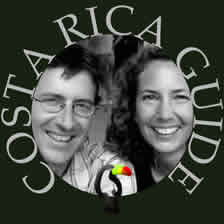A private Wildlife Refuge with acres of virgin rain forest, regenerating pasture, mangrove swamps and beaches creating one of the best bird watching locations in the world.

Established and lovingly built by fellow Coloradoan, Jack Ewing, this ranch turned nature reserve has become one of the most successful conservation projects in Costa Rica. Guided hikes, bird watching, canopy tours and a butterfly garden are just some of the activities.
trails | wildlife | getting there | best time | books | night | photos
The species lists of wildlife that’s been seen at Hacienda Barú are truly inspiring, and you won’t soon forget what you see if you decide to visit.
Hiking Trails & Activites – Hacienda Barú
The trails and activities are open to the public and many hotels and lodges in the area provide transportation. The entry fee for the Wildlife Refuge is $15 per person and other activities are priced from $30-$140 per person.
Nocturnal Nature
Lots of places have night tours as a more adventurous way to see different wildlife and Barú’s is one of the best.
For true nature lovers Hacienda Barú also goes one better offering a night in the rain forest sleeping in a tent on a platform accompanied by a naturalist guide who’ll help you get the most out of the prime wildlife viewing hours of dawn and dusk. The real fun starts as darkness falls and the nocturnal residents awaken.

Trails & Guides
All of the trails are well maintained, signed and easy to follow and your “entry ticket” to the Wildlife Refuge is actually a trail map with a validation stamp.
Although the hikes are easy to do on your own, this is one of the best places in Costa Rica to hire a guide. The in house naturalists are exceptional and there’s just so much to see that you’ll miss most of it without help. Our recommendation is to split your time and do a half day guided walk or bird watching tour then explore solo.

Without a doubt the most used paths are the ones leading to the beach. There are two options. A trail through the forest and mangroves that loops past the sea turtle incubator or an old farm road that heads straight for the water along the northwest edge of the property.

The trail through the mangroves is flat and parts are elevated on wooden walkways to keep your feet out of the muck in low spots. You’ll almost always find Capuchin monkeys, sloths and Pizotes here but there are literally hundreds of other possibilities. The photo above is taken in a different mangrove estuary north of the hiking trail where it is deep enough to float kayaks and canoes.
Whether you’re on foot or paddling don’t forget the mosquito repellent. Sometimes they’re barely noticeable but when they’re out they’re ferocious.
The mirador trail bends away from the beach, crosses the Costanera Sur roadway and then climbs steeply to a lookout platform where you can watch surfers on playa Dominical, whales offshore and birds and wildlife in the treetops below.

There is one route that can only be followed with a guide and you need to contact the office well in advance if you are interested. The archaeology tour includes general history of the indigenous people in the area as well as in situ petroglyphs and burial mounds.
Zipline – Rainforest Canopy
The “Flight of the Toucan” canopy zipline tour at Hacienda Barú is different as well. The usual zip-lines are complimented by platforms, guided tree climbs, and an electric winch driven “cable elevator” for exploration and investigation of the canopy environment at a more relaxed and educational pace.
There’s also a tower adjacent to the restaurant where you can spend as much time in the canopy as you’s like. We spotted the trogon from the cover of Skutch’s famous guide to the birds of Costa Rica the first time we climbed up.
trails | wildlife | getting there | best time | books | night | photos
Birds & Wildlife at the Refuge
Wildlife From a Hammock
It’s amazing what you’ll see right from the open air Chocolate Monkey restaurant – named for the monkeys that hang out in the surrounding coco trees breaking open the pods and eating the “chocolate” seeds. There’s gallery forest all around and birds and wildlife from the refuge are constantly overflowing into the garden.

The restaurant extends into the “yard” with thatched roof mini-palanques covering hammocks in the shade where the wait staff will be happy to take your order.
Bird Watching
The “rock stars” of Costa Rica wildlife – sloths, monkeys and jungle cats are seen here as frequently as at the famous Manuel Antonio National Park half an hour up the road but the real stars of the show here are avian.
Perhaps it’s because there are 50 times fewer people tromping around at Barú but there are always way more birds. The team at the refuge always submits record species lists to the Audubon bird count and even non-birdwatchers can easily spot dozens of colorful tropical species.




The diversity of habitats – mangrove, rain forest, gallery forest, shore, and even some small wetland areas – leads to diversity of bird species.
Merlin from the Cornell University Lab of Ornithology is an amazing, free bird id and information app now with species for Costa Rica. Just click a photo with your phone – the app automatically inserts your current GPS location and the date (for migratory status), identifies the bird, shows you more photos including male, female and juveniles, a range map, mp3 sound files with calls, and a description of habits.
Wildlife Tourism in Costa Rica
I was talking with Jack about ten years ago when the subject of competition in the tourism industry came up. We each grumbled a bit about how online marketing juggernauts like TripAdvisor an Expedia were increasing costs with hidden fees and ads disguised as awards while simultaneously decreasing quality by making every travel decision about the cheapest price. Jack mentioned that Barú had struggled a bit until they remembered their client base – wildlife lovers and birdwatchers.
It’s right there in the name “National Wildlife Refuge” and while they never strayed from the mission to protect the land and its inhabitants the growth of surf, adventure and resort tourism all around may have temporarily distracted their focus from their core visitors. Fortunately birdwatchers are all about quality and not easily fooled by marketing machines so Hacienda Barú is thriving on word of mouth and repeat visits.
trails | wildlife | getting there | best time | books | night | photos
Books on Barú
Jack Ewing has written two highly recommended books. Where Jaguars and Tapirs Once Roamed: Ever Evolving Costa Rica emphasizes the human side of the fascinating history of the refuge and the region. The stories give insight into the culture, traditions, frontier spirit and struggles to create ecotourism.
Monkeys Are Made Of Chocolate: Exotic And Unseen Costa Rica is a classic in popular natural history – a collection informative, interesting and sometimes humorous essays on the plants, insects and animals (including some humans) of the Wildlife Refuge and Dominical area.
Both books are available in the gift shop which also has one of the highest quality and most discerning collections of souvenirs, folk art and other books on Costa Rica that you’ll find anywhere.
trails | wildlife | getting there | best time | books | night | photos
Getting There
Many of the local hotels and lodges recommend the birdwatching, canopy zipline or other tours in the Wildlife Refuge and most provide package deals with transportation.
Driving
The Refuge is easy to find and easy to reach on a paved road. The turnoff is 3 km north of Dominical or 40 km south of Quepos (Manuel Antonio) on the Costanera Sur (Route 34).
Public Bus
Public Buses will typically drop you anywhere along their route including at the entrance to Hacienda Barú. Pick-up is another story though and you’ll likely have to hike, Uber or taxi the 3 km into Dominical to catch a bus. There are direct buses to/from San José and San Isidro de el General (aka Perez Zeledon – inland in the mountains). Buses headed to Uvita, Palmar Sur and points south pass through.
trails | wildlife | getting there | best time | books | night | photos
Weather, Climate & Best Time to Visit
The old cliche about whenever you can go is definitely true. Hacienda Barú is always worth a visit.
More info about the best time to visit Costa Rica and the dropdown menu has information about what it’s like each month of the year.
It can be pretty warm in the tropics and although high temperatures can be in the 90’s year round they’re mid to high 90’s in January into April. In keeping with the environmental consciousness the bungalows and rooms are not air conditioned and it doesn’t cool off much at night.
It can also be pretty wet in the rain forest but the central Pacific can be inundated in September, October and sometimes November.
So that leaves May through August and maybe November and December as our favorite times to visit.
trails | wildlife | getting there | best time | books | night | photos



